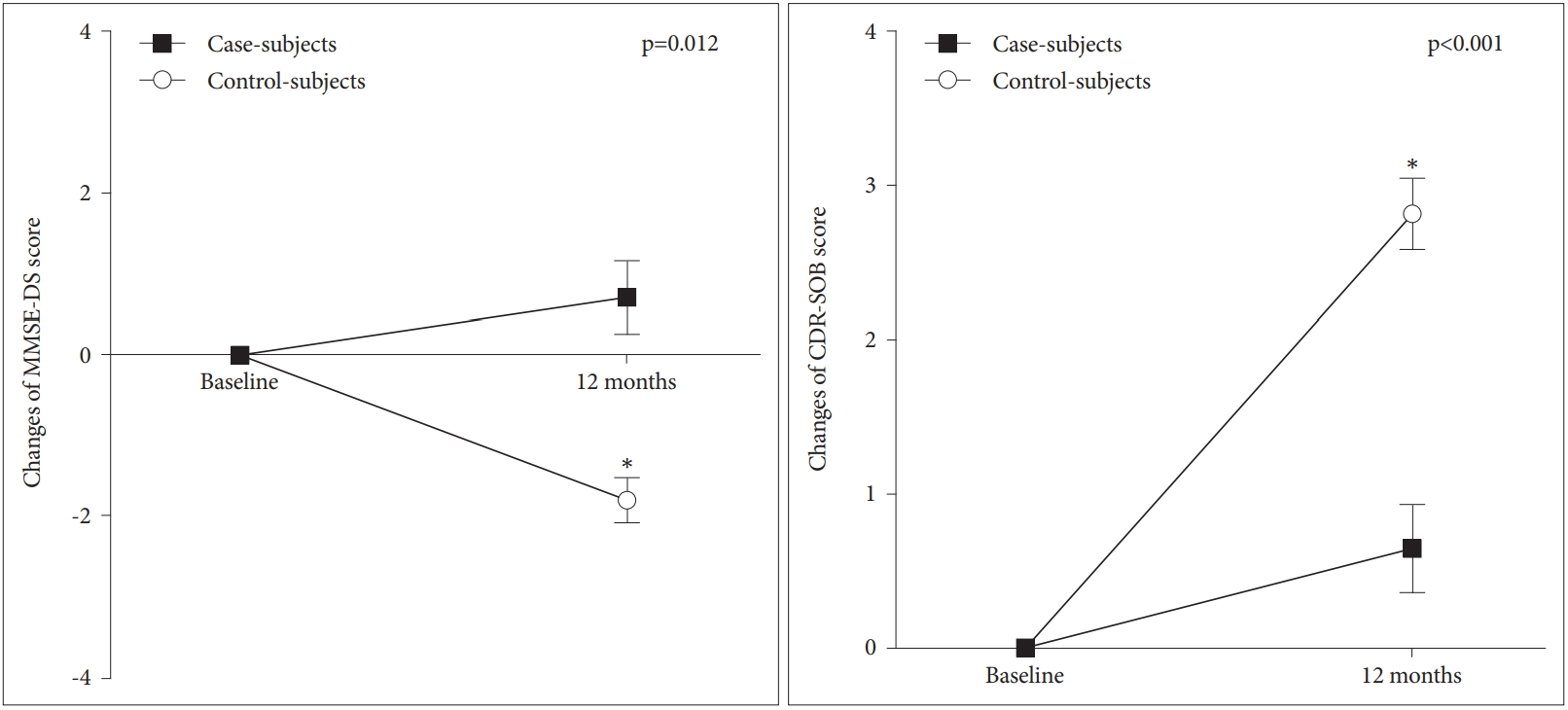 |
 |
- Search
| Psychiatry Investig > Volume 17(8); 2020 > Article |
|
Abstract
Objective
Methods
Results
The authors have no potential conflicts of interest to disclose.
Author Contributions
Conceptualization: Hyuk Sung Kwon, Hojin Choi. Data curation: Kyungtaek Yun, Jong Sook Baek, Young Un Kim. Formal analysis: Hyuk Sung Kwon, Seongho Park. Funding acquisition: Hojin Choi. Investigation: Hyuk Sung Kwon, Hojin Choi. Methodology: Hyuk Sung Kwon, Ha-rin Yang. Project administration: Hojin Choi. Supervision: Ha-rin Yang, Kyungtaek Yun, Jong Sook Baek, Young Un Kim. Validation: Hyuk Sung Kwon, Ha-rin Yang. Visualization: Hyuk Sung Kwon. WritingŌĆöoriginal draft: Hyuk Sung Kwon. WritingŌĆöreview & editing: Seongho Park, Hojin Choi.
Figure┬Ā2.

Table┬Ā1.
| Case-subjects (N=43) | Control-subjects (N=76) | p value* | |
|---|---|---|---|
| Age, mean┬▒SD (years) | 77.5┬▒4.4 | 78.3┬▒4.4 | 0.323ŌĆĀ |
| Sex, female | 31 (72.1) | 55 (72.4) | 0.974 |
| Medical history | |||
| ŌĆāHypertension | 19 (44.2) | 40 (52.6) | 0.376 |
| ŌĆāDiabetes mellitus | 16 (37.2) | 32 (42.1) | 0.601 |
| ŌĆāDyslipidemia | 11 (25.6) | 35 (46.1) | 0.028 |
| ŌĆāCardiovascular disease | 12 (27.9) | 19 (25.3) | 0.760 |
| ŌĆāCurrent smoker | 11 (25.6) | 20 (26.3) | 0.930 |
| Education, year | 5.0┬▒4.2 | 5.2┬▒4.3 | 0.819ŌĆĀ |
| Live alone | 5 (11.6) | 12 (15.8) | 0.533 |
| Family history of dementia | 12 (27.9) | 15 (19.7) | 0.307 |
| Baseline MMSE-DS score | 15.4┬▒4.9 | 15.5┬▒4.5 | 0.989ŌĆĪ |
| Follow up MMSE-DS score | 16.1┬▒6.0 | 13.7┬▒3.8 | 0.036ŌĆĪ |
| Baseline CDR-SOB score | 4.9┬▒0.7 | 5.3┬▒0.7 | 0.012ŌĆĪ |
| Follow up CDR-SOB score | 5.6┬▒2.1 | 8.0┬▒3.0 | <0.001ŌĆĪ |
| Progression of ADD | 4 (9.3) | 27 (35.5) | 0.002 |
Table┬Ā2.
Table┬Ā3.
| Not progressed (N=88) | Progressed (N=31) | p value* | |
|---|---|---|---|
| Age, mean┬▒SD (years) | 77.7┬▒4.0 | 79.0┬▒5.3 | 0.142ŌĆĀ |
| Sex, female | 60 (74.1) | 26 (68.4) | 0.521 |
| Medical history | |||
| ŌĆāHypertension | 37 (45.7) | 22 (57.9) | 0.214 |
| ŌĆāDiabetes mellitus | 36 (44.4) | 12 (31.6) | 0.182 |
| ŌĆāDyslipidemia | 25 (30.9) | 21 (55.3) | 0.011 |
| ŌĆāCardiovascular disease | 23 (28.8) | 8 (21.1) | 0.375 |
| ŌĆāCurrent smoker | 18 (22.2) | 13 (34.2) | 0.165 |
| Education, year | 4.7┬▒4.0 | 6.4┬▒4.7 | 0.058ŌĆĀ |
| Live alone | 12 (13.6) | 5 (16.1) | 0.733 |
| Family history of dementia | 19 (23.5) | 8 (21.1) | 0.770 |
| Baseline MMSE-DS score | 15.4┬▒4.3 | 15.8┬▒5.6 | 0.119ŌĆĪ |
| Follow up MMSE-DS score | 15.3┬▒4.7 | 12.4┬▒4.6 | 0.025ŌĆĪ |
| Baseline CDR-SOB score | 5.1┬▒0.7 | 5.2┬▒0.9 | 0.140ŌĆĪ |
| Follow up CDR-SOB score | 5.6┬▒1.0 | 11.7┬▒1.8 | <0.001ŌĆĪ |
| Receive cognitive training | 39 (44.3) | 4 (12.9) | 0.002 |
Table┬Ā4.
p-value for multivariate models. Data are presented as odds ratios (OR; 95% confidence interval). Adjusted for age, sex, cognitive training, education, and dyslipidemia. Progression of ADD was defined as increase in CDR-SOB score by Ōēź2 points at 12 months. ADD: AlzheimerŌĆÖs disease dementia, CDR-SOB: Clinical Dementia Rating Scale sum of boxes
REFERENCES








